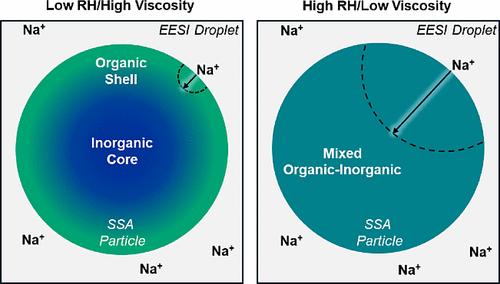当前位置:
X-MOL 学术
›
Anal. Chem.
›
论文详情
Our official English website, www.x-mol.net, welcomes your
feedback! (Note: you will need to create a separate account there.)
Effects of Relative Humidity and Phase on the Molecular Detection of Nascent Sea Spray Aerosol Using Extractive Electrospray Ionization
Analytical Chemistry ( IF 6.7 ) Pub Date : 2024-07-24 , DOI: 10.1021/acs.analchem.4c02871 Samantha M Kruse 1 , Paul R Tumminello 1 , Alexia N Moore 1 , Christopher Lee 2 , Kimberly A Prather 1, 2 , Jonathan H Slade 1
Analytical Chemistry ( IF 6.7 ) Pub Date : 2024-07-24 , DOI: 10.1021/acs.analchem.4c02871 Samantha M Kruse 1 , Paul R Tumminello 1 , Alexia N Moore 1 , Christopher Lee 2 , Kimberly A Prather 1, 2 , Jonathan H Slade 1
Affiliation

|
Online mass spectrometry techniques, such as extractive electrospray ionization mass spectrometry (EESI-MS), present an attractive alternative for analyzing aerosol molecular composition due to reduced aerosol sample collection and handling times and improved time resolution. Recent studies show a dependence of EESI-MS sensitivity on particle size and mixing state. This study measured authentic sea spray aerosol (SSA) components generated during a phytoplankton bloom, specifically glycerol, palmitic acid, and potassium ions. We demonstrate temporal variability and trends dependent on specific biological processes occurring in seawater. We found that the EESI-MS sensitivity, after adjusting for pressure variations at the inlet and normalizing to the reagent ion, critically depends on the sample’s relative humidity. Relevant SSA species exhibited heightened sensitivity at an elevated relative humidity near the deliquescence relative humidity of sea salt and poorer sensitivity with sparse detection below the efflorescence relative humidity. Modeling the reagent ion’s diffusive depth demonstrates that the sample aerosol particle viscosity governs the relative humidity dependence because it modulates the particle’s coagulation efficiency and distance the reagent ion diffuses and reacts with components in the particle bulk. The effects of particle size and mixing state are discussed, revealing improved sensitivity of phase-separated components present along the particle surface. This work highlights the importance of the particle phase state in detecting and quantifying molecular components within authentic and complex aerosol particles and the utility of EESI-MS for measuring SSA composition.
中文翻译:

相对湿度和相位对采用萃取电喷雾电离的新生海浪喷雾气溶胶分子检测的影响
在线质谱技术,例如萃取电喷雾电离质谱 (EESI-MS),由于减少了气溶胶样品收集和处理时间并提高了时间分辨率,为分析气溶胶分子成分提供了一种有吸引力的替代方案。最近的研究表明 EESI-MS 灵敏度依赖于颗粒尺寸和混合状态。这项研究测量了浮游植物繁殖过程中产生的真实海喷雾气溶胶 (SSA) 成分,特别是甘油、棕榈酸和钾离子。我们证明了取决于海水中发生的特定生物过程的时间变化和趋势。我们发现,在调整入口处的压力变化并标准化试剂离子后,EESI-MS 灵敏度主要取决于样品的相对湿度。相关 SSA 物种在接近海盐潮解相对湿度的较高相对湿度下表现出较高的灵敏度,而在低于风化相对湿度时则表现出较差的检测稀疏。对试剂离子扩散深度的建模表明,样品气溶胶颗粒粘度控制相对湿度依赖性,因为它调节颗粒的凝结效率以及试剂离子扩散并与颗粒主体中的成分反应的距离。讨论了颗粒尺寸和混合状态的影响,揭示了颗粒表面存在的相分离组分的灵敏度提高。这项工作强调了颗粒相态在检测和量化真实和复杂气溶胶颗粒中分子成分的重要性,以及 EESI-MS 在测量 SSA 成分方面的实用性。
更新日期:2024-07-24
中文翻译:

相对湿度和相位对采用萃取电喷雾电离的新生海浪喷雾气溶胶分子检测的影响
在线质谱技术,例如萃取电喷雾电离质谱 (EESI-MS),由于减少了气溶胶样品收集和处理时间并提高了时间分辨率,为分析气溶胶分子成分提供了一种有吸引力的替代方案。最近的研究表明 EESI-MS 灵敏度依赖于颗粒尺寸和混合状态。这项研究测量了浮游植物繁殖过程中产生的真实海喷雾气溶胶 (SSA) 成分,特别是甘油、棕榈酸和钾离子。我们证明了取决于海水中发生的特定生物过程的时间变化和趋势。我们发现,在调整入口处的压力变化并标准化试剂离子后,EESI-MS 灵敏度主要取决于样品的相对湿度。相关 SSA 物种在接近海盐潮解相对湿度的较高相对湿度下表现出较高的灵敏度,而在低于风化相对湿度时则表现出较差的检测稀疏。对试剂离子扩散深度的建模表明,样品气溶胶颗粒粘度控制相对湿度依赖性,因为它调节颗粒的凝结效率以及试剂离子扩散并与颗粒主体中的成分反应的距离。讨论了颗粒尺寸和混合状态的影响,揭示了颗粒表面存在的相分离组分的灵敏度提高。这项工作强调了颗粒相态在检测和量化真实和复杂气溶胶颗粒中分子成分的重要性,以及 EESI-MS 在测量 SSA 成分方面的实用性。

















































 京公网安备 11010802027423号
京公网安备 11010802027423号